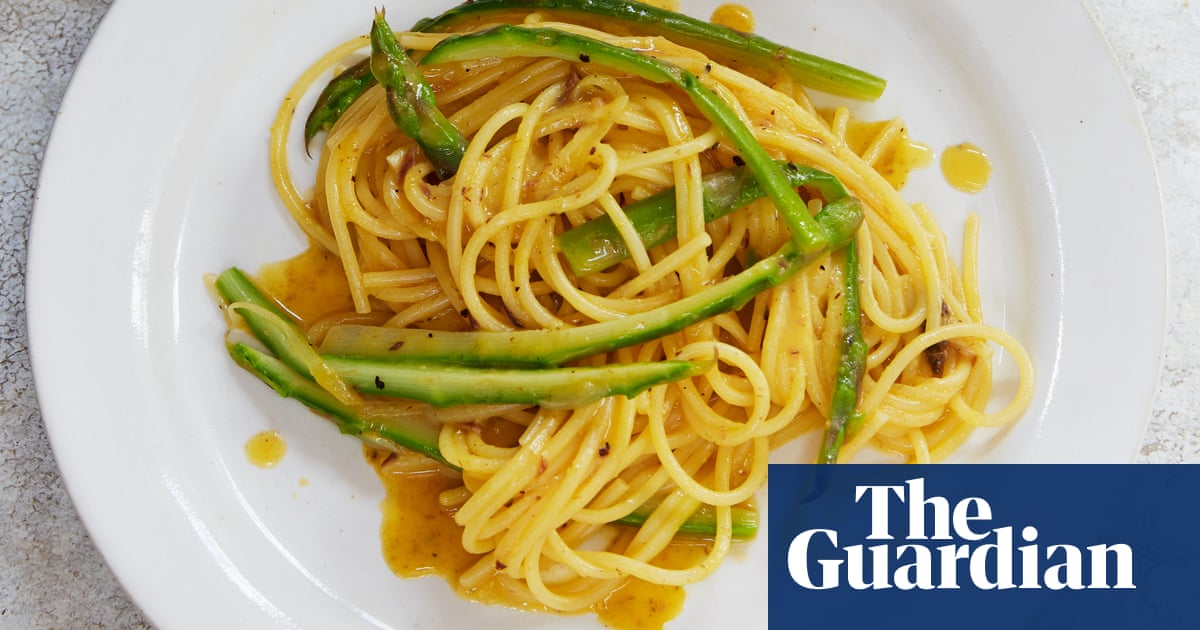What unexpected things can I make with asparagus?“The goal is to do as little as possible to it,” says Ben Lippett, author ofHow I Cook(published in September). “If you start dressing upasparaguswith fancy cooking techniques, you lose its magic.” That’s not to say you should just boil the spears and be done with it, mind: “Try pairing them with relatively high-impact flavours, but nothing that will steal the show,” Lippett says. “Much as with a salad dressing, you want something with richness, fragrance, acidity and salinity.” Instead of a gribiche-style sauce, for example, sub inKewpie(Japanese mayo), pickled ginger, chives, sesame seeds and frozen peas “to make a spoonable condiment”. Or cook asparagus chunks with lots of butter and a shot of water, then “finish with lemon and grapefruit segments, cracked hazelnuts and sheets of comté”.
Asparagus recipes often lean towards salads, which is all well and good until the weather misses the spring memo. And, in that scenario,Sophie Wyburd, author ofTucking In, has your back with a warm, in-between-seasons side. “Make a salsa verde with loads of mint, basil, parsley, capers and dijon mustard, then blister chopped asparagus in a very hot frying pan with a little water to get that steam going.” Once tender, toss with plump chickpeas: “That goes particularly well with roast lamb or chicken,” she says. Ramuel Scully, executive chef and co-owner ofScullyin central London, meanwhile, steams his spears to “keep them super-sweet”, then adds some tea – “Try oolong” – to the boiling water to “infuse the asparagus with extra flavour”. Finish off with salt and a squeeze of lemon, then top with crispy chilli oil and tahini: “Both work great with asparagus.”
Another spring-worthy side from Lippett comes viaTomos ParryofBratandMountainfame, who taught him the technique: “Cook little bundles of asparagus in a very hot oven,” he says. “Use a strip of spring onion or wild garlic to wrap them up, with some herbs and slivers of ginger or chilli in there, too.”
Alternatively, whip up a tempura batter and fry them to a crisp: “It’s quite easy,” saysSally Abé, head of food atthe Bullin Charlbury, Oxfordshire, and author ofA Woman’s Place in the Kitchen. Abé uses 50:50 rice flour and cornflour, plus sparkling water to guarantee they go nice and crisp once deep-fried. She says these little morsels are a treat dunked into wild garlic mayo, say.
Finally, for the kind of comfort that only carbs can provide, go for a sort of carbonara, Wyburd says: “I won’t actually call it that, because people get upset, but it’s essentially a pasta sauce with egg yolks, pecorino, loads of lemon zest and maybe some lemon juice.” Blanch chopped asparagus in the water you’re cooking the pasta in, drain then toss with everything else.
While “not revolutionary”, another great idea iscrema di asparagi, or cream of asparagus, saysIxta Belfrage, author ofFusao(out in August): “Cook chopped asparagus in salted water until tender, then put in a blender with lemon juice, salt, olive oil, a splash of cream, a good grating of parmesan and some nutmeg, and blitz smooth, adding hot water to loosen.” The result? A vibrant pasta sauce orsoupthat could even be served chilled, assuming the weather plays ball: “Just add some finely chopped raw asparagus at the end for a bit of texture.
Got a culinary dilemma? Emailfeast@theguardian.com
